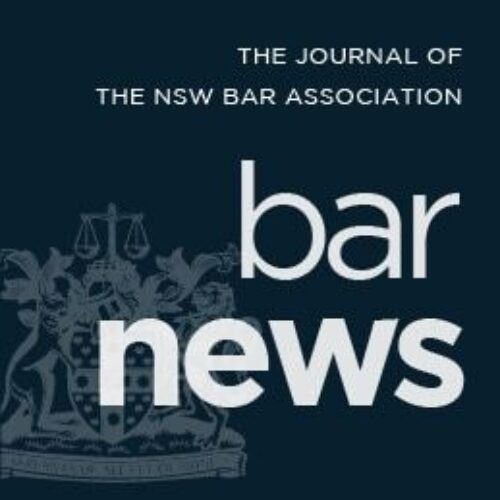- Winter 2023
- Breaking and entering your own house? A right to exclusive possession prevails over occupancy BA v The King [2023] HCA 14
Breaking and entering your own house? A right to exclusive possession prevails over occupancy BA v The King [2023] HCA 14

In BA v The King the High Court considered the element of ‘breaking and entering’ in the offence of break enter and commit serious offence under s 112 of the Crimes Act 1900 (NSW). The essential question was whether the element of breaking and entering could be made out where a person had a right to exclusive possession under a lease even though they were not an occupier. The facts turned on the occupier’s refusal of entry to a leaseholder who has ceased to occupy the premises.
The majority of the High Court determined the matter in favour of BA. Liability did not obtain because he held a right to exclusive possession under a lease. The Court was split on the question 4:3.
Facts
The appellant, BA, intimidated and assaulted his former partner in their former home, after kicking open the door of the house.
BA and the victim had lived together in an apartment in Queanbeyan as co-tenants with a residential tenancy agreement. After separating from the victim, BA moved out of the premises. On the day of the offences, he remained a leaseholder, a ‘tenant at law’: at [38]. On the day of the incident, BA attended the apartment and demanded to be let in. The victim refused. The offending conduct followed.
The principal question at trial, and on appeal, was whether the element of breaking and entering could be made out. BA was found not guilty at trial by directed verdict; he pleaded guilty to the alternative offences of common assault, intimidation and destroying property, admitting the essential conduct alleged.
Majority judgment
Gordon, Edelman, Steward and Gleeson JJ determined that the element of ‘breaking and entering’ required a trespass, entry to another’s premises without authority: at [42], [61]. They found that it was well established that a person with a right of exclusive possession of a premises could not commit the element of breaking.
This was demonstrated by a summary of cases where breaking and entering was not made out: an owner breaking into the chamber of a resident; a joint occupier breaking into the part of premises occupied by another; a landlord entering a room owned by him; a lodger at an inn stealing from the inn (holding a contractual right of entry). This was contrasted with a leased room where the owner has no right of immediate possession: at [61].
On the facts in the matter, the lease held by BA allowed him exclusive possession of the premises, and this right meant that he was not entering as a trespasser: at [69]-[70].
The majority rejected alternative arguments by the respondent Crown. First, that the applicant was not an occupier and the sole occupier refused entry: at [77]-[82]. Second, that the applicant’s intention (in assault and intimidation) was unrelated to ‘residence’ in the lease and under the Residential Tenancies Act 2010 (RTA); and third, the RTA’s prohibition on damage meant that BA was a trespasser. Essentially, the majority held that exclusive possession was not offset by purpose, or by breach of the RTA. Statutory provisions allowed for termination of leases, relevantly for damage or for domestic violence, and no termination was evidenced: at [81].
It is worth noting that the majority said that the ‘meaning… was established in historical circumstances quite different from contemporary society, including when domestic and family violence was generally not treated as criminal’: at [36].

Minority judgment
The minority judgment of Keifel CJ, Gageler and Jagot JJ, relied on an actual textbook approach to the element of ‘breaking and entering’, finding that the issue turned on occupation rather than the right to exclusive possession. Their Honours determined that the use of force against the will of the occupier satisfied the test of lack of authorisation and was sufficient to make out a break: at [25].
In stark contrast to the majority’s approach to the analysis, the minority pressed the dissent as a contemporary interpretation of the offence provision:
This is a result which reflects the values of a contemporary civilised society. Nothing seems more apt to risk serious disturbances of social peace and good order and to engender potential violence against people in their own homes than concluding that, in kicking the door down to enter, and then assaulting his former partner (and if he intended to do so, whether or not he in fact assaulted her, as he did in this case), the appellant committed no crime.
It might be noted that BA admitted liability for the three offences of intimidation, common assault and property damage. Those offences were clearly aggravated by having been committed in a person’s home, and orthodox sentencing principle marks the seriousness of domestic violence offending.
Licencees – unlawful or innocent intent?
Both the majority and minority referred in footnotes to Barker v The Queen (1983) 153 CLR 338 (Barker), which ruled on a similar issue in the context of a licence-holder.
In Barker, a licence-holder was guilty of (Victorian) burglary as a trespasser. His permission to enter his neighbour’s house extended to looking after the premises, but not to entering for an unlawful purpose: at 341-42, per Mason J. What might be described as ‘innocent entry’ appears to be closely consistent with the minority position. ‘Innocent entry’ may also bear some analogical similarity to in the idea of ‘innocent mistake’ as recently confirmed in Bell v Tasmania (2021) 395 ALR 589; [2021] HCA 42 (see Bar News Autumn 2022).
Given the decision of the majority in BA, the legal position in criminal law is now very likely to be different for licence-holders and leaseholders. The crucial question is whether a person holds a right of exclusive possession.
Ultimately, for the crime of breaking and entering in NSW, an occupier’s exclusion does not override a leaseholder’s right to exclusive possession. This is the case whether the act of breaking is otherwise innocent or malicious. BN
